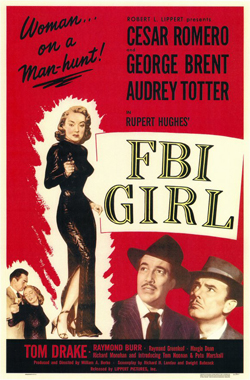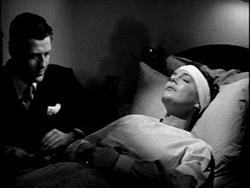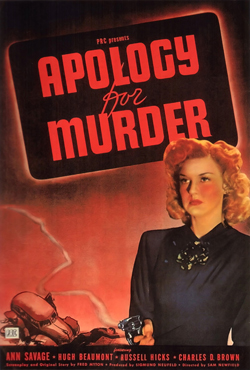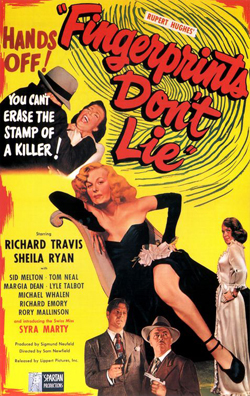
You will be forgiven if you have no idea who these guys are, but back in the forties they were two of the most prolific directors in Hollywood. Working on the lowest rung of the Dream Factory ladder, they each churned out scores of films. Each worked in many different genres. Each made money. Each made crap.
Take William Berke. This guy was a one-man movie-making machine. Between 1942 and 1950, he directed sixty-three movies. Sixty-three. In eight years. To put that in some perspective, during this same time frame Orson Welles directed four movies.
With that kind of output, you can bet the results are sloppy and uneven. Take FBI Girl (1951), a noir about the FBI starring Audrey Totter and Raymond Burr. Even though it stars one of noir’s greatest goddesses and one of noir’s great villains, it still stinks. Totter doesn’t have anything to do here except look pretty, so it’s up to Burr—with his massive bulk and unblinking reptilian eyes—to give the movie its only shot of interest. He barely pulls it off.

And wow, to get that hour of my life back…
Shoot to Kill is dreadful in ways that are shocking to a modern audience. The acting is appalling. The dialog is clunky and boring. Berke cuts corners in nearly every scene—including a five-minute musical number that exists just to drag this piece of shit over the one-hour mark.
Bad as he was, though, Berke was no match for Sam Newfield, a director for whom the term “prodigious” does not begin to cut it. This guy made William Berke look like Stanley Kubrick. Estimates put his filmography somewhere between 275-325 films. Working under four different names (to hide the fact that his company, PRC, was largely a one-man show), Newfield produced movies like he was making fries at McDonald’s. In 1945 alone he directed twelve movies. You read that right. Twelve movies in one year.

Still, necessity being the mother of invention, Newfield’s camera work and mise en scene aren’t completely bad most of the time. The script was originally called, believe it or not, Single Indemnity and was written by Fred Myton—a PRC hack who churned out scripts as often as most people brush their teeth—but it is not without some snap in the dialog (possibly inserted by Edgar G. Ulmer in an uncredited punch-up). Like any cheap little thriller, Apology for Murder depends on its cast to make it work, and the film is blessed to have Ann Savage (Detour) on board as the femme fatale. This film stinks, but any movie with Savage holds some interest.
A more representative exhibit from the Newfield school of industrial film manufacturing, however, would be Fingerprints Don’t Lie. Clocking in at a limp fifty-six minutes, the film doesn’t have much time for a story, so it doesn’t tell much of one. What story there is concerns a young painter who has been convicted of murder largely on the strength of the testimony of a fingerprint expert, James Stover. Stover is confronted by the mayor’s daughter. She’s convinced that the painter is innocent, so together she and Stover try to find the real killer.

Sam Newfield was possibly the most prolific director who ever worked in Hollywood, a dubious honor when you realize that Fingerprints Don’t Lie was typical of his work. A movie like this is a funny thing. It is a 100% con job, existing for no other reason than to trick people into giving away their money. Back in 1951, it was clearly designed to fill out a double bill and fool people into thinking they were getting a second feature. Here’s the funny thing, though: it still exists for the sole reason of tricking people into giving away their money. Today, you will find it wedged into comprehensive packages alongside other dubious “classics” of noir, but I’m not even sure it qualifies as film noir. It’s a crime story, but visually it’s as tepid as flat beer. Worse still, Newfield uses Sid Melton, PRC’s resident goofball, to wedge in ten minutes of vaudeville comic bits. When you have to pad out a movie that’s not even an hour long, you know you’re churning out something useless.
A post like this basically functions as a public service announcement. Stay clear. Protect your money. I watched the movies of Berke and Newfield so you wouldn’t have to. Do not let my sacrifice be in vain!
Jake Hinkson, The Night Editor

Thanks for the warning. Can you tell me the name of a real hidden gem that I wouldn’t be able to find on my own?
Thanks for the comment, Debroah! For my money the most underrated classic noir is a seldom seen movie called Roadblock. Great tragic romance with Charles McGraw and Joan Dixon. Hard to find but worth the look. You can read about it [url=http://thenighteditor.blogspot.com/2009/08/best-film-noir-most-people-havent-seen.html]here[/url].
An easier film to find would be Too Late For Tears (sometimes billed as “Killer Bait”) with Lizabeth Scott. It’s a masterpiece, now in the public domain, widely available in rough condition. The Film Noir Foundation is committed to restoring it. Hopefully that will happen soon. Read about it [url=http://thenighteditor.blogspot.com/2009/12/too-late-for-tears-1949.html]here[/url].
A valuable public service indeed. Berke at least closed out his career with COP HATER, a solid, sweaty adaptation of an Ed McBain 87th Precinct novel.
They all sound like complete stinkers. Fantastic. Rushing out now, to see if I can find any! Reminds me of a review of a first time film maker. “I know this gentleman has never made a film before, but having sat through this debut – I wonder if he has ever actually seen one….”